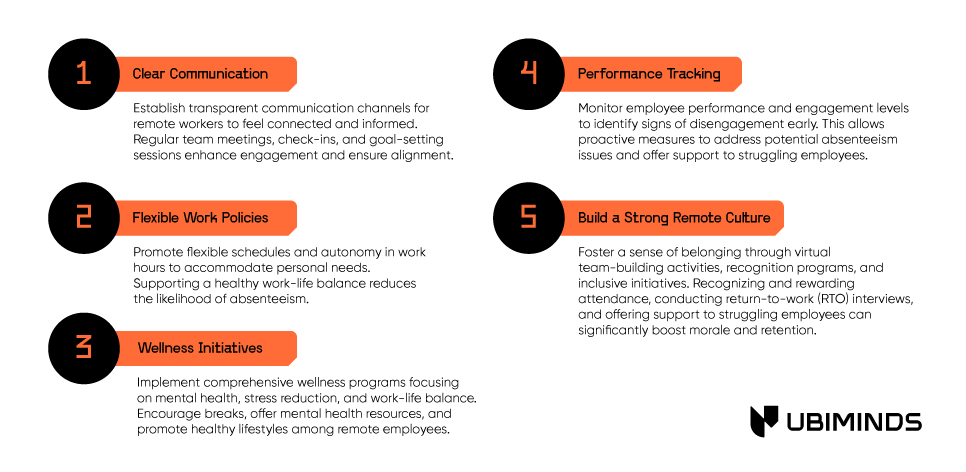As remote work became commonplace, absenteeism began to pose a significant challenge for distributed teams. When engineers go AWOL, it can lead to communication breakdowns, causing delays in the Continuous Integration/Continuous Deployment (CI/CD) pipeline. Repeated absences can hamper collaboration, affecting the team’s rhythm and impacting the speed and quality of software releases. Here’s how SaaS companies can address this issue and ensure optimal productivity in their remote work environments.
Absenteeism among technical staff in SaaS companies can lead to three significant setbacks:
- It disrupts the development sprint, causing delays in feature releases, which directly impacts the competitive edge in the market.
- It hampers the overall team morale, affecting the collaborative spirit within the engineering squad, leading to lowered productivity and innovation.
- It might jeopardize client satisfaction due to delayed product updates or unmet project deadlines, potentially impacting customer retention and trust.
This trifecta of setbacks can significantly dent a SaaS company’s growth trajectory and market positioning. So let’s learn how to deal with it!
What Exactly is Absenteeism in Remote or Distributed Teams?
Absenteeism in remote or distributed teams refers to employees being consistently unavailable during scheduled work hours without prior notice or legitimate reasons. Burnout, demotivation, and that fuzzy line between work and home life can all fuel this phenomenon.
FAQ on Absenteeism in Software Companies
Types of Absenteeism in Remote or Distributed Teams
Understanding absenteeism in remote or distributed teams, including challenges faced by software developers in Latin America, goes beyond the usual no-show scenario. Planned absenteeism, like scheduled work-from-home days, can foster balance, while unanticipated absence due to technical issues or prolonged disconnection during work hours hampers productivity and team morale.
| Planned Absenteeism | Unplanned Absenteeism | Intermittent Absenteeism |
|---|---|---|
| This occurs when employees take scheduled time off, such as vacations or planned personal days. While this can be beneficial for employees' mental health, excessive planned absenteeism can disrupt team workflow, especially if not managed effectively. | This is when employees are absent due to unexpected reasons, like illness or emergencies. While occasional unplanned absenteeism is inevitable, excessive occurrences can impact project timelines and team dynamics. | This type involves sporadic absences, where employees are frequently absent in short bursts. This can disrupt continuity in tasks, affecting project momentum and team collaboration. |
In remote work, fostering a culture supporting remote work while staying connected is crucial. Embracing reliable communication tools, nurturing engagement via video calls, and offering flexible work hours help teams navigate absenteeism challenges and build a vibrant remote work environment.
Causes of Employee Absenteeism
Employee absenteeism can stem from various factors, impacting workplace dynamics and productivity. Some common causes include:
- Burnout: Prolonged stress and overwhelming workloads often lead to burnout, prompting employees to take time off to recuperate and prevent further exhaustion.
- Workplace Bullying or Harassment: Hostile work environments due to bullying or harassment can contribute to absenteeism as affected employees may avoid work to avoid such situations.
- Childcare and Eldercare Responsibilities: Balancing work with childcare or eldercare responsibilities can lead to unplanned absences when unexpected caregiving needs arise.
- Illness or Injury: Employee absenteeism due to personal illness, injury, or medical appointments is a common cause of unplanned time off work.
- Mental Health Concerns: Mental health issues, including anxiety, depression, or stress-related conditions, regularly lead to absences from work as employees focus on managing their mental well-being.
- Commuting Issues: Challenges in commuting, such as traffic congestion, transportation delays, or long travel distances, can sometimes result in tardiness or absenteeism.
Understanding these causes helps organizations implement targeted strategies to address them, fostering a healthier work environment and reducing absenteeism.
Calculating Absenteeism and Acceptable Rates
Calculating absenteeism involves tallying up missed work hours or days against the total available work hours. Acceptable rates of absenteeism vary across industries and organizations. Generally, a rate of around 2-3% is considered typical, accounting for planned and unplanned absences.
However, reasons for absenteeism can affect acceptability; for instance, absences due to illness or family emergencies may be more reasonable than frequent unplanned absences without valid reasons.
Understanding and managing acceptable rates are crucial, especially in industries focusing on cost-effectiveness and internationalization. High levels of absenteeism can disrupt project timelines, influence team morale, and hinder overall productivity. Establishing clear policies and fostering an environment where employees feel supported in managing their work-life balance can help maintain reasonable absenteeism rates while ensuring the team’s efficiency and well-being.
5 Tips on How to Mitigate Absenteeism in Remote Teams
Mitigating absenteeism in remote teams requires fostering a work culture where employees feel engaged and motivated. Encouraging remote work means empowering them to manage work hours effectively, communicate seamlessly, and collaborate extensively.
- Clear Communication: Establish transparent communication channels for remote workers to feel connected and informed. Regular team meetings, check-ins, and goal-setting sessions enhance engagement and ensure alignment.
- Flexible Work Policies: Promote flexible schedules and autonomy in work hours to accommodate personal needs. Supporting a healthy work-life balance reduces the likelihood of absenteeism.
- Wellness Initiatives: Implement comprehensive wellness programs focusing on mental health, stress reduction, and work-life balance. Encourage breaks, offer mental health resources, and promote healthy lifestyles among remote employees.
- Performance Tracking: Monitor employee performance and engagement levels to identify signs of disengagement early. This allows proactive measures to address potential absenteeism issues and offer support to struggling employees.
Build a Strong Remote Culture: Foster a sense of belonging through virtual team-building activities, recognition programs, and inclusive initiatives. Recognizing and rewarding attendance, conducting return-to-work (RTO) interviews, and offering support to struggling employees can significantly boost morale and retention.

5 Tips on How to Mitigate Absenteeism in Remote Teams
Investing in collaboration tools enables seamless communication and teamwork while working remotely. Establishing ‘house teams’ within the larger team allows better communication and enhances productivity. These strategies coupled with a robust framework for communication tools significantly reduce absenteeism.
Prioritizing collaboration practices that facilitate communication and seamless work is essential. Creating smaller teams within the larger team enhances communication and productivity. These strategies, complemented by a strong communication framework, minimize absenteeism while maximizing remote team effectiveness.
Disciplinary Action (When, Who, and How)
Employ disciplinary measures when absenteeism persists despite support and intervention. HR, in conjunction with team leads, should be involved in a fair and consistent manner, following company policies. This might involve verbal warnings, written notices, or escalating consequences, adhering to predetermined procedures. However, the focus should always be on understanding underlying reasons and providing support where possible.
Supporting Tech Leaders in Managing Absenteeism: A PeopleOps Perspective
PeopleOps / Human Resources and upper management play a crucial role in supporting tech leaders from product and engineering teams to effectively manage absenteeism among remote team members.
They can champion initiatives for employee engagement, collaboration within software development, and that aim to improve productivity. Here are some examples of how this takes shape:
- Organizing regular cross-functional team workshops or hackathons to encourage collaboration and innovative thinking.
- Implementing mentorship or buddy programs to facilitate knowledge sharing and skill development among software engineers.
- Establishing dedicated time for ‘innovation days’ or ‘creative sessions’ where engineers can work on passion projects or explore new technologies.
- Hosting virtual or in-person meetups, tech talks, or seminars where engineers can share insights or best practices.
- Encouraging participation in open-source projects or industry-related events to expand networks and stay updated on industry trends.
- Creating forums or internal platforms for idea sharing and discussions to facilitate collaboration and teamwork.
- Recognizing and celebrating achievements, whether individual or team-based, to foster a culture of appreciation and motivation.
- Offering training sessions or resources for soft skills development, such as communication or leadership, alongside technical training.
Also, strategies such as bringing in staff augmentation from Latin America or partnering with nearshore software developers can also alleviate pressure on engineering teams, optimizing product development and engineering team performance.
Ubiminds’ Approach to Absenteeism Mitigation
At Ubiminds, we specialize in optimizing remote team management strategies to combat absenteeism and elevate productivity. Our approach revolves around leveraging digital transformation to enhance the remote work experience. We prioritize high-level engagement by facilitating regular video calls and enabling flexible work hours, empowering seamless remote work without compromising productivity.
Partnering closely with our client companies, we co-create an inclusive remote work culture that champions clear communication and fosters work-life harmony. Our tailored strategies are designed to minimize absenteeism, maximize productivity, and cultivate a thriving remote work environment for distributed teams.
Effectively managing absenteeism is pivotal for distributed team success, and our solutions are meticulously crafted to optimize remote team management. Explore how our strategies can benefit your remote team by scheduling a consultation today.

Ubiminds’ Head of Relationship Success Lucas Carvalho blends 7+ years in customer success leadership with a passion for the sports industry, co-founding the Recife Mariners. His mastery in strategic planning and fostering stakeholder engagement significantly influences organizations, notably guiding SaaS companies on their journey to expand their teams.





